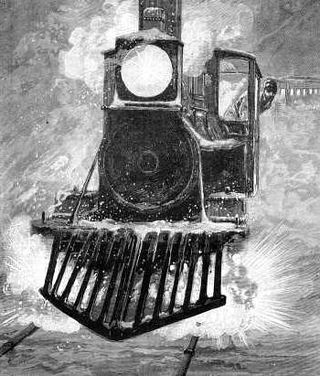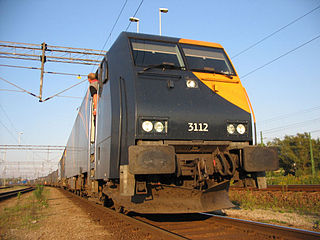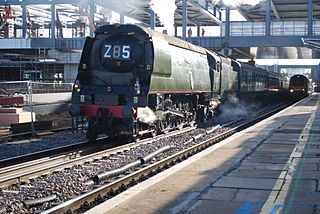
The railway system in Great Britain is the oldest railway system in the world. The first locomotive-hauled public railway opened in 1825, which was followed by an era of rapid expansion. Most of the track is managed by Network Rail, which in 2017 had a network of 15,811 kilometres (9,824 mi) of standard-gauge lines, of which 5,374 kilometres (3,339 mi) were electrified. These lines range from single to quadruple track or more. In addition, some cities have separate metro, light rail and tram systems. There are also many private railways, which are primarily short lines for tourists. The main rail network is connected with that of continental Europe by the Channel Tunnel and High Speed 1, which fully opened in 1994 and 2007 respectively.

Network Rail Limited is the owner and infrastructure manager of most of the railway network in Great Britain. Network Rail is an "arm's length" public body of the Department for Transport with no shareholders, which reinvests its income in the railways.
The Ladbroke Grove rail crash was a rail accident which occurred on 5 October 1999 at Ladbroke Grove in London, England, when two passenger trains collided almost head-on after one of them had passed a signal at danger. With 31 people killed and 417 injured, it was one of the worst rail accidents in 20th-century British history.
There are effectively two separate mainline railway systems in the United Kingdom – the Great Britain system and the Northern Ireland system, which are regulated and operated separately, and are constituted under separate pieces of United Kingdom legislation.
The privatisation of British Rail was the process by which ownership and operation of the railways of Great Britain passed from government control into private hands. Begun in 1994, it had been completed by 1997. The deregulation of the industry was initiated by EU Directive 91/440 in 1991, which aimed to create a more efficient rail network by creating greater competition.

The Hatfield rail crash was a railway accident on 17 October 2000, at Hatfield, Hertfordshire. It was caused by a metal fatigue-induced derailment, killing four people and injuring more than 70.

West Coast Railways (WCR) is a railway spot-hire company and charter train operator based at Carnforth MPD in Lancashire. Using buildings and other facilities previously owned by the Steamtown Carnforth visitor attraction, in June 1998 the company became the first privately owned company to be given a licence as a train operating company.

A signal passed at danger (SPAD), known in the United States as a stop signal overrun and in Canada as passing a stop signal, is an event on a railway where a train passes a stop signal without authority. In the United States and Canada, this may be known colloquially as running a red, though this idiom principally refers to automobiles passing red traffic signals.

The Office of Rail and Road (ORR) is a non-ministerial government department responsible for the economic and safety regulation of Britain's railways, and the economic monitoring of National Highways.

Rail Alphabet is a neo-grotesque sans-serif typeface designed by Jock Kinneir and Margaret Calvert for signage on the British Rail network. First used at Liverpool Street station, it was then adopted by the Design Research Unit (DRU) as part of their comprehensive 1965 rebranding of the company.

A train event recorder – also called On-Train Monitoring Recorder (OTMR), On-Train Data Recorder (OTDR), Event Recorder System (ERS), Event Recorder Unit (ERU), or Juridical Recording Unit (JRU) – is a device that records data about the operation of train controls, the performance of the train in response to those controls, and the operation of associated control systems. It is similar in purpose to the flight data recorder or black box used on aircraft.

A railway detonator is a coin-sized device that is used as a loud warning signal to train drivers. It is placed on the top of the rail, usually secured with two lead straps, one on each side. When the wheel of the train passes over, it explodes, emitting a loud bang. It was invented in 1841 by English inventor Edward Alfred Cowper.

In the early evening of 8 August 1996, a Class 321 passenger train operated by Network SouthEast travelling from London Euston on the West Coast Main Line Down Slow line at around 110 km/h (68 mph) passed a signal at danger. Having applied the brakes it eventually stopped 203 m past the signal and was traversing the junction between the Down Slow line and the Up Fast line. An empty Class 321 coaching stock train approaching at roughly 80 km/h (50 mph) collided with the stationary passenger train approximately 700 m south of Watford Junction whilst progressing across the connections from the Up Slow line to the Up Fast line.
A near miss, near death, near hit or close call is an unplanned event that has the potential to cause, but does not actually result in human injury, environmental or equipment damage, or an interruption to normal operation.

One-person operation (OPO), also known as driver-only operation (DOO), one-man operation (OMO), single person train operation (SPTO), or one-person train operation (OPTO), similarly to Driver Controlled Operation, is operation of a train, bus, or tram by the driver alone, without a conductor.

Automatic block signaling (ABS), spelled automatic block signalling or called track circuit block (TCB) in the UK, is a railroad communications system that consists of a series of signals that divide a railway line into a series of sections, called blocks. The system controls the movement of trains between the blocks using automatic signals. ABS operation is designed to allow trains operating in the same direction to follow each other in a safe manner without risk of rear-end collision.

The Confidential Incident Reporting & Analysis Service (CIRAS) is a confidential safety reporting service for health, safety and wellbeing concerns raised by workers in the UK transport industry. It is funded by members and run independently, though is a wholly owned subsidiary of Rail Safety and Standards Board (RSSB). The service covers the following sectors: passenger and freight train operators, light rail, Network Rail and its suppliers, London Underground, and Transport for London (TfL) bus operators.
Heritage Operations Processing System, Heritage Ops, or HOPS, is a web-based tool for the day-to-day running and management of preserved and heritage railways. The system was developed, from a concept drawn up by Danny Scroggins and Luke Cartey.

On 7 March 2015, a steam-hauled charter train passed a signal at danger and subsequently came to a stand across a high-speed mainline junction near Wootton Bassett Junction, Wiltshire, England. Another train, which had right of way, had passed through the junction 44 seconds earlier and no collision occurred nor was any damage done.

Trains include a variety of types of lights, for safety, illumination, and communicating train status. The most universal type of light is the headlight, which is included on the front of locomotives, and frequently on the rear as well. Other types of lights include classification lights, which indicate train direction and status, and ditch lights, which are a pair of lights positioned towards the bottom of a train to illuminate the tracks.















